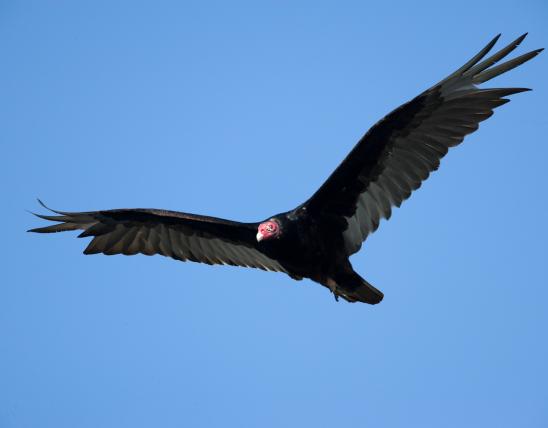
Adult northern harriers have long wings and tail, a white rump patch, and an owl-like facial disk. The female is brown and streaked below; the male is gray above and white below; in flight, from below, the male's whitish body contrasts with black wingtips and black trailing edge to wings. Immature birds are similar to the adult female but are darker chestnut-colored on the breast and belly and are streaked only on the breast. The flight pattern is distinctive: gliding low over the ground, wings held in a shallow V, with buoyant, nimble, tilting movements. Calls include high whistles and barks.
Similar species: The various buteo hawks are larger, chunkier, with wider, more rounded wings and shorter tails. Although both turkey vultures and rough-legged hawks share the habit of flying with wings in a V-shape, neither flies low over the ground like the northern harrier. Cooper’s and sharp-shinned hawks have long tails, but their wings are shorter and rounder; also, they aren’t common in grasslands. The northern goshawk is gray, but lacks the white rump patch, and like the Cooper’s, it doesn’t fly slowly over the ground.
Length: 18–22 inches; wingspan: 40–47 inches.

Statewide. In winter, more common in southern Missouri than in the north.
Habitat and Conservation
Northern harriers are usually seen over prairies, marshes, and hay fields as they forage with their distinctive flight pattern, gliding slowly across the open areas, wings raised in a shallow V like a turkey vulture’s. The common name is a form of the word harrower, which means “pillager” or “plunderer.” From the perspective of their prey, that would aptly describe this hawk’s attack from above.
Food
Northern harriers forage in open areas for rodents, birds, snakes, and insects. They fly over fields within a few yards of the ground, listening for their prey moving in the grass below. They hover over one spot, and plunge feet-first into the vegetation to capture prey. This species, and Swainson’s hawk, are most likely to appear at grassland or crop stubble fires during the spring and fall, when they can be seen preying on animals fleeing the fire. The smoke from distant fires often attracts raptors, especially these two species.
Status
Endangered within Missouri; in peril of extirpation within our borders; a species of conservation concern. Uncommon migrant seen in prairies, marshes, and hay fields. Uncommon winter resident. Rare and local summer resident in extensive grassland landscapes. Northern harriers occur across North America and Eurasia.
Life Cycle
Populations in Missouri peak during migration: from late February through the end of April, and from mid-September through the end of November. The winter territory for North American harriers includes Missouri and areas south, into northern South America. Nests are built on the ground, usually in dense, low vegetation, and are platforms made from the thick plant stalks and lined with finer grasses. Clutches comprise 4–5 eggs, which are incubated for about a month. Two weeks after hatching, the young are ready to leave the nest. There is only 1 brood a year. Northern harriers can live to be at least 15 years old.
Human Connections
Harriers are nimble, graceful fliers and are a pleasure to watch. Harrier populations have been declining steadily in the last 50 years, mainly due to human actions: The draining of wetlands, large-scale agriculture, and other activities that have caused loss of habitat. Efforts to eradicate rodent pests have caused a reduction of prey animal populations. And when people poison rodents and other prey species, the hawks that eat the poisoned animals can be killed.
Ecosystem Connections
Both the northern harrier and owls have round faces encircled by stiff facial feathers. This adaptation functions like a sonar disk by channeling sound waves to their ears. Thus it helps these predatory birds hear the rustlings of prey concealed beneath vegetation. Though both harriers and owls share this adaptation, they are not related. Most other hawks rely mainly on sight to locate prey.




























About 350 species of birds are likely to be seen in Missouri, though nearly 400 have been recorded within our borders. Most people know a bird when they see one — it has feathers, wings, and a bill. Birds are warm-blooded, and most species can fly. Many migrate hundreds or thousands of miles. Birds lay hard-shelled eggs (often in a nest), and the parents care for the young. Many communicate with songs and calls.
































